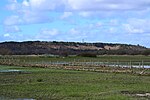RAF Winkton

Royal Air Force Winkton or more simply RAF Winkton is a former Royal Air Force Advanced Landing Ground previously in Hampshire but now, due to County boundary changes, in Dorset, England. The airfield is located approximately 3 miles (4.8 km) north of Christchurch; about 89 miles (143 km) southwest of London, and is named after the nearby hamlet of Winkton. Although complete by September 1943 Winkton opened in March 1944 with Sommerfeld Mesh runways and pierced steel planking perimeter tracks, and was the prototype for the type of temporary Advanced Landing Ground type airfield that would be built in France after D-Day, when the need for advanced landing fields would become urgent as the Allied forces moved east across France and Germany. It was used by British, Dominion and the United States Army Air Forces. It was closed in July 1944, when the mesh runways were lifted for use on the Continent, and immediately returned to agriculture. Today the airfield is a mixture of agricultural fields with no recognizable remains.
Excerpt from the Wikipedia article RAF Winkton (License: CC BY-SA 3.0, Authors, Images).RAF Winkton
Derritt Lane, New Forest Sopley
Geographical coordinates (GPS) Address Nearby Places Show on map
Geographical coordinates (GPS)
| Latitude | Longitude |
|---|---|
| N 50.776944444444 ° | E -1.7672222222222 ° |
Address
Derritt Lane
Derritt Lane
BH23 8AP New Forest, Sopley
England, United Kingdom
Open on Google Maps







